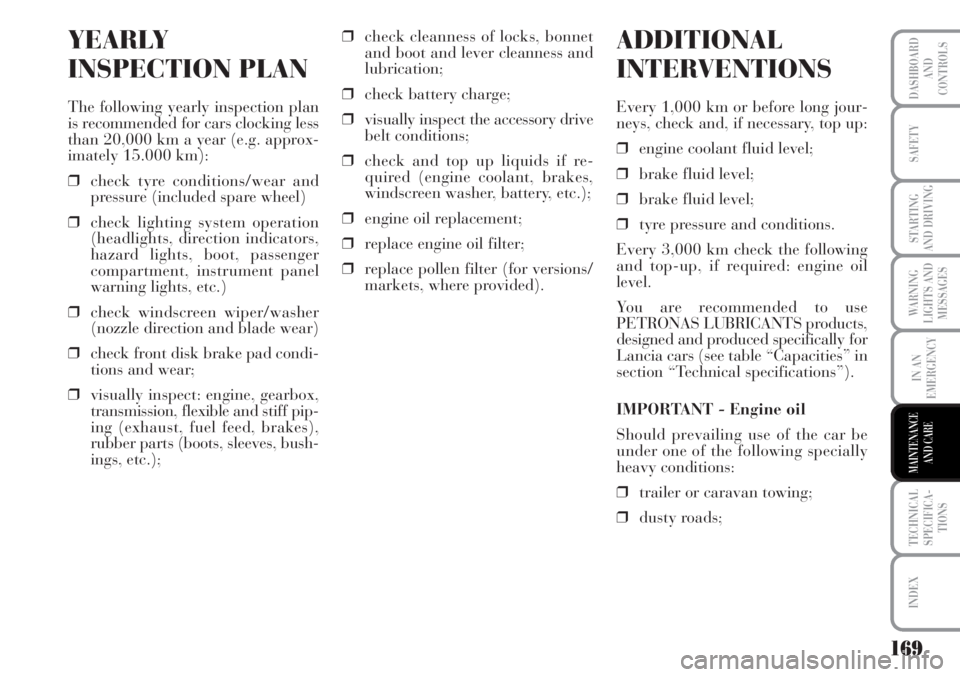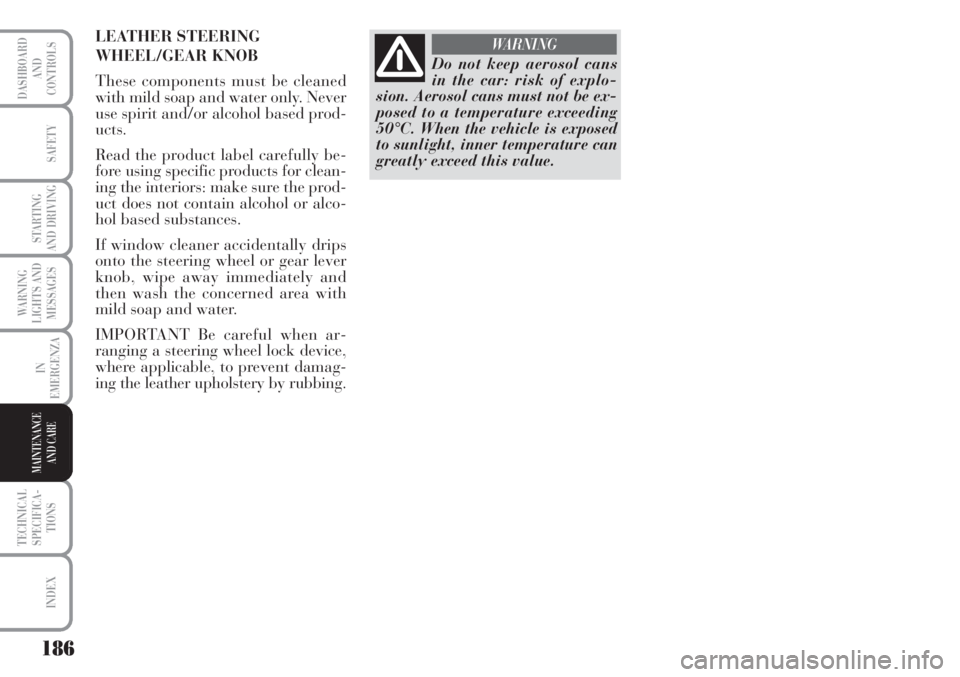2010 Lancia Musa wheel
[x] Cancel search: wheelPage 166 of 218

165
WARNING
LIGHTS AND
MESSAGES
TECHNICAL
SPECIFICA-
TIONS
INDEX
DASHBOARD
AND
CONTROLS
SAFETY
STARTING
AND DRIVING
IN AN
EMERGENCY
MAINTENANCE
AND CARE
MAINTENANCE AND CARE
SCHEDULED SERVICING............................... 166
SERVICE SCHEDULE................................... 167
YEARLY INSPECTION PLAN ......................... 169
ADDITIONAL INTERVENTIONS ..................... 169
CHECKING THE LEVELS............................... 171
FUEL FILTER (green filter).............................. 177
BATTERY ......................................................... 177
WHEELS AND TYRES ..................................... 179
RUBBER HOSES .............................................. 180
WINDSCREEN/REAR WINDOW
WIPER/WASHER ............................................. 181
BODYWORK.................................................... 182
INTERIORS....................................................... 185
Page 170 of 218

169
WARNING
LIGHTS AND
MESSAGES
TECHNICAL
SPECIFICA-
TIONS
INDEX
DASHBOARD
AND
CONTROLS
SAFETY
STARTING
AND DRIVING
IN AN
EMERGENCY
MAINTENANCE
AND CARE
YEARLY
INSPECTION PLAN
The following yearly inspection plan
is recommended for cars clocking less
than 20,000 km a year (e.g. approx-
imately 15.000 km):
❒check tyre conditions/wear and
pressure (included spare wheel)
❒check lighting system operation
(headlights, direction indicators,
hazard lights, boot, passenger
compartment, instrument panel
warning lights, etc.)
❒check windscreen wiper/washer
(nozzle direction and blade wear)
❒check front disk brake pad condi-
tions and wear;
❒visually inspect: engine, gearbox,
transmission, flexible and stiff pip-
ing (exhaust, fuel feed, brakes),
rubber parts (boots, sleeves, bush-
ings, etc.);❒check cleanness of locks, bonnet
and boot and lever cleanness and
lubrication;
❒check battery charge;
❒visually inspect the accessory drive
belt conditions;
❒check and top up liquids if re-
quired (engine coolant, brakes,
windscreen washer, battery, etc.);
❒engine oil replacement;
❒replace engine oil filter;
❒replace pollen filter (for versions/
markets, where provided).
ADDITIONAL
INTERVENTIONS
Every 1,000 km or before long jour-
neys, check and, if necessary, top up:
❒engine coolant fluid level;
❒brake fluid level;
❒brake fluid level;
❒tyre pressure and conditions.
Every 3,000 km check the following
and top-up, if required: engine oil
level.
You are recommended to use
PETRONAS LUBRICANTS products,
designed and produced specifically for
Lancia cars (see table “Capacities” in
section “Technical specifications”).
IMPORTANT - Engine oil
Should prevailing use of the car be
under one of the following specially
heavy conditions:
❒trailer or caravan towing;
❒dusty roads;
Page 180 of 218

179
WARNING
LIGHTS AND
MESSAGES
TECHNICAL
SPECIFICA-
TIONS
INDEX
DASHBOARD
AND
CONTROLS
SAFETY
STARTING
AND DRIVING
IN AN
EMERGENCY
MAINTENANCE
AND CARE
IMPORTANT A battery which is kept
at a charge of less than 50% (optical
indicator with dark colour without
green area in the middle) for any
length of time will be damaged by sul-
phation leading to a reduction in
cranking power.
The battery will also be more at risk
of freezing (e.g. already at -10°C).
In case of prolonged halt, refer to the
“Storing the car” paragraph in the
“Starting and driving” chapter.
If after buying the car, you want to in-
stall electric accessories which require
permanent electric supply (alarm,
etc.) contact Lancia Dealership whose
qualified personnel, in addition to
suggesting the most suitable devices
from Lineaccessori Lancia, will eval-
uate the overall electric absorption,
checking whether the car’s electric
system is capable of withstanding the
load required, or whether it should be
integrated with a more powerful bat-
tery.
Since these devices continue absorb-
ing energy even when the ignition key
is off, they gradually run down the
battery.WHEELS AND
TYRES
Check the pressure of each type, in-
cluding the spare, approximately once
every two weeks and before starting a
long journey: this check must be per-
formed with the tyre rested and cold.
It is normal for pressure to increase
when the car is used. For the correct
tyre inflation pressure, see “Wheels”
in “Technical specifications” section.
Incorrect pressure causes abnormal
tyre wearfig. 15:
A: normal pressure: evenly worn
tread.
B: low pressure: tread particularly
worn on the edges.
C: excessive pressure: tread particu-
larly worn in the middle.
The tyres must be replaced when the
tread is less than 1.6 mm thick. In all
cases, follow the laws in force in the
country where you are driving.IMPORTANT NOTES
❒Avoid braking suddenly, burning
starts and violent knocks against
the curb, potholes or other obsta-
cles if possible. Long distances on
rough roads may damage the tyres;
❒check the tyres regularly for cuts on
the sides, swelling or irregular tread
wear. Go to a Lancia Dealership if
required.
❒Do not overload your vehicle: this
may cause serious damage to
wheels and tyres;
❒if a tyre is punctured, stop the ve-
hicle immediately and charge it to
avoid damage to the tyre, the rim,
suspensions and steering system;
fig. 15L0D0216m
Page 181 of 218

180
WARNING
LIGHTS AND
MESSAGES
TECHNICAL
SPECIFICA-
TIONS
INDEX
DASHBOARD
AND
CONTROLS
SAFETY
STARTING
AND DRIVING
IN
EMERGENZA
MAINTENANCE
AND CARE
❒a tyre will age even if it is not used
much. Cracks in the tread and on
the sidewalls are a sign of ageing.
Have the tyres checked by spe-
cialised personnel if they have been
fitted for longer than 6 years. Re-
member to check the spare wheel
very carefully;
❒In case of replacement, always fit
new tyres, avoiding those with an
unknown origin.
❒If a tyre is replaced, also change the
inflation valve.
❒to allow even wear between the
front and rear tyres, it is advisable
to change them over every 10-15
thousand kilometres, keeping them
on the same side of the car so as not
to reverse the direction of rotation.
Remember that the road
holding qualities of your
car also depends on the correct in-
flation pressure of the tyres.
WARNING
Excessively low pressure
will cause overheating of
the tyre and may cause severe tyre
damage.
WARNING
Do not exchange the tyres
from the left to the right of
the car and vice versa.
WARNING
Do not repaint alloy wheel
rims at temperatures
higher than 150°C. The mechani-
cal features of the wheels could be
compromised.
WARNING
RUBBER HOSES
Carefully follow the information con-
tained in the “Service schedule” in
this section for maintenance of brake
system and fuel feed rubber hoses.
Ozone, high temperatures and pro-
longed lack of fluid in the system may
cause hardening and cracking of the
hoses, with possible leaks. Careful in-
spections are therefore necessary.
Page 187 of 218

186
WARNING
LIGHTS AND
MESSAGES
TECHNICAL
SPECIFICA-
TIONS
INDEX
DASHBOARD
AND
CONTROLS
SAFETY
STARTING
AND DRIVING
IN
EMERGENZA
MAINTENANCE
AND CARE
Do not keep aerosol cans
in the car: risk of explo-
sion. Aerosol cans must not be ex-
posed to a temperature exceeding
50°C. When the vehicle is exposed
to sunlight, inner temperature can
greatly exceed this value.
WARNINGLEATHER STEERING
WHEEL/GEAR KNOB
These components must be cleaned
with mild soap and water only. Never
use spirit and/or alcohol based prod-
ucts.
Read the product label carefully be-
fore using specific products for clean-
ing the interiors: make sure the prod-
uct does not contain alcohol or alco-
hol based substances.
If window cleaner accidentally drips
onto the steering wheel or gear lever
knob, wipe away immediately and
then wash the concerned area with
mild soap and water.
IMPORTANT Be careful when ar-
ranging a steering wheel lock device,
where applicable, to prevent damag-
ing the leather upholstery by rubbing.
Page 188 of 218

TECHNICAL SPECIFICATIONS
IDENTIFICATION DATA .................................. 188
ENGINE CODES -
BODYWORK VERSIONS.................................. 190
ENGINE........................................................... 191
FUEL FEED .................................................... 192
TRANSMISSION .............................................. 192
BRAKES........................................................... 193
SUSPENSIONS ................................................. 193
STEERING SYSTEM ........................................ 193
WHEELS .......................................................... 194
DIMENSIONS ................................................... 198
PERFORMANCE.............................................. 199
WEIGHTS........................................................ 200
CAPACITIES .................................................... 201
FLUIDS AND LUBRICANTS ............................ 202
FUEL CONSUMPTION.................................... 204
CO
2EMISSIONS ............................................... 205
187
WARNING
LIGHTS AND
MESSAGES
INDEX
DASHBOARD
AND
CONTROLS
SAFETY
STARTING
AND DRIVING
IN AN
EMERGENCY
MAINTENANCE
AND CARE
TECHNICAL
SPECIFICA-
TIONS
Page 194 of 218

BRAKES
Service brakes:
– front
– rear
Parking brake
IMPORTANT Water, ice and salt sprinkled on the roads may deposit on the brake disks reducing braking efficiency the first time the
brakes are applied.
(
▲) Engine version for some versions/markets only 1.4
8V(▲)-1.416V- 1.3 Multijet 70 HP
Self-ventilating discs (257 mm x 22 mm)
Drum (203 mm x 38 mm)
Operated by hand lever, acting on
rear brakes
SUSPENSIONS
Front
Rear
(
▲) Engine version for some versions/markets only 1.4
8V(▲)-1.416V- 1.3 Multijet - 1.6 Multijet
McPherson independent wheels
Semi-independent wheels interconnected by means of torque axle
STEERING SYSTEM
Type
Steering circle
(kerb to kerb) m
(
▲) Engine version for some versions/markets only 1.4
8V(▲)-1.416V- 1.3 Multijet - 1.6 Multijet
Rack and pinion with electric power steering
10,0
1.3 Multijet 90 HP - 1.3 Multijet 95 HP
1.6 Multijet
Self-ventilating discs (284 mm x 22 mm)
1.3 Multijet 90 HP -1.3 Multijet 95 HP: drum
(228 mm x 40 mm)
1.6 Multijet: disc (240 mm x 11 mm)
Operated by hand lever, acting on
rear brakes
193
WARNING
LIGHTS AND
MESSAGES
INDEX
DASHBOARD
AND
CONTROLS
SAFETY
STARTING
AND DRIVING
IN AN
EMERGENCY
MAINTENANCE
AND CARE
TECHNICAL
SPECIFICA-
TIONS
Page 195 of 218

WHEELS
RIMS AND TYRES fig. 5
Pressed steel or alloy rims. Tubeless
radial carcass tyres. All approved
tyres are listed in the Log Book.
IMPORTANT In the event of discrep-
ancies between the information pro-
vided on this “Owner’s handbook”
and the “Log book”, consider the
specifications shown in the log book
only.
Respect the prescribed size to ensure
safety of the car in movement. Fit
tyres of the same make and type on
all wheels.
IMPORTANT Do not use inner tubes
with Tubeless tyres.
SPACE SAVER SPARE WHEEL
Pressed steel rim Tubeless tyre.
WHEEL GEOMETRY
Front wheel toe-in measured between
rims: 0 ±1 mm.
The values refer to the car in running
order.HOW TO READ TYRE DATA
Example: 185/65 R 14 86 T
185= Nominal width (S, distance in
mm between sidewalls).
65= Percentage height/width ratio
(H/ S).
R= Radial tyre.
14= Rim diameter in inches (Ø).
86= Load rate (capacity).
T= Maximum speed rating.
fig. 5L0D0229m
194
WARNING
LIGHTS AND
MESSAGES
INDEX
DASHBOARD
AND
CONTROLS
SAFETY
STARTING
AND DRIVING
IN AN
EMERGENCY
MAINTENANCE
AND CARE
TECHNICAL
SPECIFICA-
TIONS
If after-sale tyres with rim
protector are used (fig. 6)
and the car has integral caps fixed
(by springs) to the sheet wheel, DO
NOT fit wheel caps. The use of un-
suitable tyres and wheel caps could
cause a sudden pressure loss of the
tyre.
WARNING
fig. 6L0D0502m
RIM PROTECTOR TYRES fig. 6